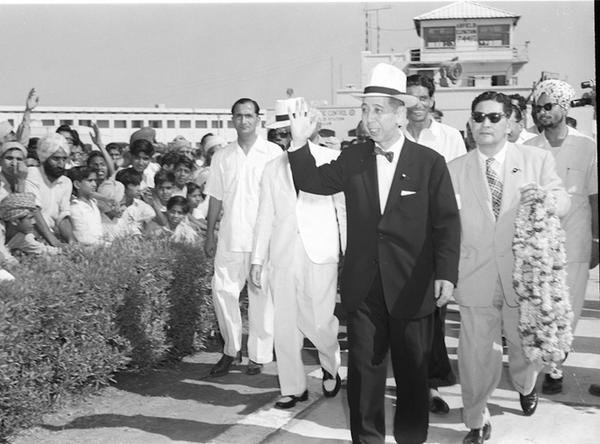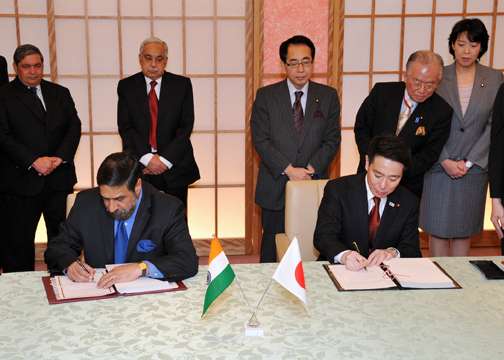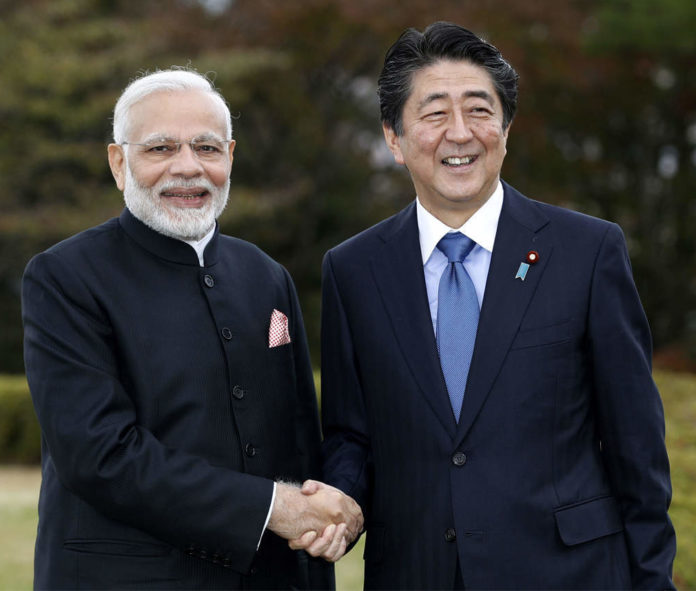South Asian political history under an intense competition between India and Pakistan has always been a problematic picture in international relations. The hegemonic desires of New Delhi forced its Hindu leadership to establish strategic connection with extra-regional powers which cannot only help India in asserting its offensive capabilities but also help it in enhancing its strategic muscles. The desire to acquire an influential role in regional politics of South Asia by threatening sovereign values of neighbouring states is the fundamental goal of India’s hostile neighbourhood policy which has maintained a record of multidimensional disputes with its territorially adjoining nations. Hindu policymakers of India obsessed with anti-neighbourhood foreign policy are determined to obtain the support of a superpower. Moreover, New Delhi is committed to maintain its foreign relations with technologically advanced and industrially developed nations. Japan is one of the developed countries which has always been of high priority of New Delhi’s foreign relations, and willing to help India in every required field. The relations between two states comprise a rich history of bilateral efforts and reciprocal visits of leaders.
The cultural relations between two states based on ideological strings of Buddhism ensured a strong connection between both governments. The ancient teachings of Siddhartha Gautama (also known Gautama Buddha or simply Buddha) started between sixth and fourth centuries BCE and travelled toward Japan. Apart from Buddhist connections, the exchange of bilateral cultural values was structured after the Second World War in 1948 when the Nehru government gifted an Indian baby elephant called “Indira” to Japan for its Ueno zoo located in Tokyo during the Prime Minister Shigeru Yoshida regime. The two state authorities further agreed to lay the foundations of bilateral interaction by signing of a peace treaty on April 28, 1952. Japanese occupation by Allied forces and Indian independence after the British colonial retreat from the subcontinent were the initial circumstances which forced the leaders from both sides to construct cooperative bonds for supporting each other in the international politics. The Treaty of Peace between Japan and India also written in Japanese language defined the early cooperative objectives of both states in its eleven articles. Under a two-sided economic collaboration, the fifty sixth and fifty seventh Prime Minister of Japan, Nobusuke Kishi visited India in 1957 and activated Tokyo’s economic aid to Nehru regime. Prime Minster Kishi, the grandfather of Shinzo Abe announced the first yen loan plan for India. In order to highlight the close cultural associations, the Japanese leaders placed a monument honouring Justice Radha Binod Pal at Yasukuni shrine of Tokyo. India justice Pal favoured Japan through his judgement during the International Military Tribunal for the Far East. The tribunal is also recognized internationally as Tokyo Trials or Tokyo War Crimes Tribunal formed in 1946 for carrying out military trials against Japanese officers. Justice Pal’s participation in the Tribunal and support for Japan later became an important symbol of diplomatic bilateralism between Tokyo and New Delhi.
The diplomatic bonds between Tokyo and New Delhi are inherited in the San Francisco Peace Conference of 1951. Treaty of San Francisco or commonly known as Peace Treaty with Japan was an agreement between Japan and Allied Powers of the World War II. Indian state officials refused to attend this gathering of forty eight nations and conveyed its concerns against the imposed limitations on Tokyo’s sovereign and independence status. Then the finalizing of peace treaty in 1952 waived off all elements of concern between Japan and India and diplomatically bracketed the two nations closely. The initials leadership of both counties decided to start a two-sided journey of economic, social, technological and strategic cooperation. The democratic parliamentary political systems in the two countries proved to be another reason for establishing bilateral diplomatic connections because Japan’s emperor is a symbolic part of Tokyo’s constitutional body.

The decade of 1950s marked major developments in their bilateral interaction. A major breakthrough occurred in November 1955 when both agreed on sharing of their aviation services and signed a pact for civil aviation services. The aviation agreement helped them in maintaining Direct Air Services. Later development of this agreement connected the two-sided airlines, and both governments were able to collect revenue through air traffic. The frequency of two flights per week was only an economic source, but it strengthened their diplomatic bonds. Furthermore, in response to Nobusuke Kishi’s visit to India, Pandit Nehru planned a reciprocal visit in October 1957 along with his daughter Indira Gandhi. This visit Gandhi resulted in greater cooperation in the field of economic development, trade and investment under a trade deal in 1958. In this way, an era of unlimited reciprocal visits of business communities, high profile state officials, and leading diplomats started between the two countries. In 1961 Japanese Prime Minister Hayato Ikeda visited India, this visit was responded by India in 1969 with the similar visit by Indira Gandhi. The exchange of official visits between two nations were mutual efforts for defining the bilateral foundations of respect, goodwill, and friendship. The vision of common respect and dignity in different areas of cooperation were further enhanced in the last two decades of the twentieth century when bilateral meetings reached their zenith before the challenges of globalization and twenty first century emanated.
The bilateral framework of Tokyo & New Delhi further flourished during the East-West division of international relations under the greater politics of Cold War. The US-USSR decades long clash dragged Tokyo and New Delhi away from each other, because the consequences of the Second World War proclaimed Japan to be a close ally of the United States whereas Nehru decided to stay away from the US under its Non Aligned Policy. Nehru’s apparent decision of keeping a distance from the Cold War politics shifted India into the anti-US bloc and resulted in Indo-Soviet relations. In this way, Japan and India joined opposite blocs of the Cold War and both states were unable to constitute the common basis for close bilateral interaction. Instead of locating in different alliances immediately after the end of World War II, the leader of Japan and India signed a peace treaty in which they declared under Article eleven of the treaty that “there shall be firm and perpetual peace and unity between India and Japan and their people.” In 1956, Japan’s application for joining the United Nations after accepting the American sponsored security arrangement was heavily supported by the first Indian Prime Minister Jawaharlal Nehru. During the Indo-China war of 1962 over Tibet, the American intervention under the greater designs of Cold War did not only support New Delhi, but it also encouraged Washington’s main allies from Pacific region to support Nehru’s anti-China position. New Delhi’s global lobbying in addition to America compelled the states of Southeast Asian and South Pacific regions to join Nehru’s anti-Beijing campaign. Japan played a leading role in constructing of India’s anti-Mao coalition under the larger American alliance.
Recently New Delhi has arranged an international event Global Partnership Summit (GPS) under the bigger concept of India Japan Global Partnership (IJGP) which was an effort to bring the people of the two nations to a joint forum. This event was planned to amalgamate the energies of two countries against the emerging challenges of the twenty first century. The GPS was mainly structured to give impetus to new socio-economic framework comprising on three principles such as Energy-Efficiency, Environmental responsibility and Responsibility (E-E-S). In participating the bilateral event, the two governments envisioned fostering cooperation in the areas of mutual benefits. In order to deepen the vision of IJCP, Indian government decided to host a visit of Japanese officials in 2005.
In 2005, Japanese Prime Minister Junichiro Koizumi with the Indian counterpart, Manmohan Singh signed an Eight-fold initiative under greater Japanese-Indian Global Partnership. The Eight-fold plan was constructed to cover eight different areas of cooperation: first to enhance bilateral high level cooperation for initiating of strategic dialogues, second to increase economic collaboration which will compel the two-sided leaders to explore further developments for economic partnership agreements between two states, third to strengthen bilateral dialogues for security and cooperation, fourth to improve cooperation in the domain of science and technology, fifth to enhance people-to-people contacts under the broader cultural and academic activities, sixth to boost bilateral efforts in ushering a new Asian era, seventh to promote their cooperative connections in international and regional multilateral forums like the United Nations, exclusively for bringing the reforms in Security Council, and eighth to foster bilateral collaborative struggles against the emerging challenges of globalization while crafting supportive opportunities for each other. One of the key features of the Eight-fold plan was to mark the year 2007 as a memorable year of Japan-India Friendship to memorialise the Golden Jubilee of 1957 Cultural Agreement between New Delhi and Tokyo. In order to celebrate the completion of fiftieth year of bilateral friendship, Japanese leadership arranged “Japan in India” program and a massive wave of celebrations consisting of 250 events spread across India.

The leading state officials from New Delhi and Tokyo agreed to sign an economic agreement and finalized a Comprehensive Economic Partnership Agreement (CEPA) on February 16, 2011.This economic pact was designed to boost economic development in India and the principles of cooperation between two nations are outlined under 147 articles of CEPA’s draft. Article one of the draft agreement defined the main objectives of CEPA such as liberalizing trade, increasing investment opportunities, improving business conducive environment, establishing a framework of closer cooperation, etc. Moreover, the Ink 15 Agreement has been signed between the state officials of Japan and India, this is designed to enhance cooperation in multiple fields including civil aviation, trade, science and technology, and skill development. In this way, the leaders from both sides intend to expand the scope of ever widening bilateral ties.
Bilateral relations between Tokyo and New Delhi has emerged in various fields including, science and technology, trade and investment, politics and security, and social and cultural affairs. A smooth diplomatic layer of two-sided multifaceted interaction has witnessed numerous bilateral developments which is a feature of contemporary international relations. Japan and India are collaborating in different fields of politics, economic, social and cultural affairs. The point that should be of serious attention is the strategic dimension in which Indian objectives are very much clear New Delhi under its regional hegemonic goals is determined to expand its influence over the territorial and oceanic politics of South Asia by jeopardizing the sovereign positions of other regional states generally and neighbouring states particularly. The bilateral interaction especially in the civil nuclear field is an alarming development which is going to augment the existing foundations of security collaboration between the two nations. Beyond civil nuclear dealing of Tokyo and New Delhi, constant naval exercises is another feature of their strategic cooperation. Various strategic developments under the hawkish leadership of Modi can push the entire South Asian region towards more crisis by further endangering regional peace and stability on the basis of supportive policies of Japan. The direct impact of Indo-Japan multilateral ties can lead Tokyo toward an anti-Pak-China alliance which will be the second part of this article. In the second portion to be published in the next issue of this magazine, the strategic dimensions of Tokyo-Japan alliance and its impact on South Asia or Pakistan specifically will be covered.




